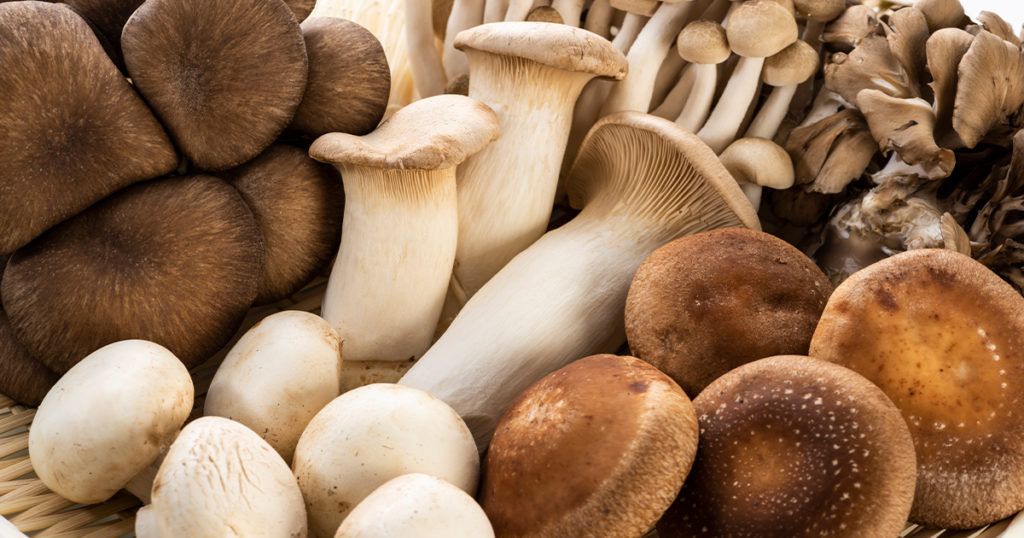Mushrooms are classified as spore-bearing fungi. Interestingly, they are not considered plants since they do not require sunlight for energy and contain no chlorophyll, that green photosynthetic pigment found in plants, algae, and cyanobacteria required to absorb energy. Mushrooms rely on other plant material for energy production.
Although mushrooms have only been systematically researched for their health-promoting properties and nutritional benefits for a few decades, they have been historically used for therapeutic purposes for over 1,000 years.
What makes these unique fungi so popular even today? We break down the research for you here.
Historical use of mushrooms
There are an estimated 10,000 species of mushrooms in the world. However, only about 300 mushrooms are edible (1).
For centuries, mushrooms have been incorporated into meals, consumed as teas or powders, and used in traditional medicine. Today, they are found in culinary dishes and dietary supplements for additional health support. In fact, there are more than 1,000 scientific publications examining the effects mushrooms have on the immune system alone (2-4).
Traditionally consumed in Japan as either a tea or powder for its medicinal, rather than its nutritional, value, reishi mushroom has been highly regarded and touted for its overall health benefits. Multiple studies have suggested reishi mushrooms support normal immune system function (5-8). In addition to reishi mushrooms, maitake and poria mushrooms contain unique polysaccharides that beneficially modulate the immune system to promote normal, healthy function (2-4).
Modern–day use of mushrooms
The use of mushrooms in culinary dishes has increased over the century. More people are incorporating mushrooms into everyday cuisine for their earthy and umami flavor profiles. Common mushrooms found in grocery stores in the United States are white button, portobello, and cremini mushrooms.
Do these common mushrooms have any potential health benefits?
Research has suggested that commonly consumed mushroom species could be a potential source of dietary vitamin D (9). Additionally, white button mushrooms may have potential health benefits by supporting normal immune function (10).
For some, mushrooms may be an afterthought. However, scientific research shows the potential for overall health benefits that may encourage you to incorporate mushrooms into your normal diet.
References
- Royse, D. Specialty mushrooms and their cultivation. Horticultural Reviews. 1997;19:59-97.
- Rios JL. Chemical constituents and pharmacological properties of Poria cocos. Planta Medica 2011 May;77(7):681-691.
- Mayell M. Maitake extracts and their therapeutic potential – a review. Altern Med Rev. 2001 Nov;60(3):258-274.
- Wasser SP. Medicinal mushrooms as a source of antitumor and immunomodulating polysaccharides. Appl Microbiol Biotechnol. 2002 Nov;60(3):258-274.
- Wachtel-Galor et al. Ganoderma lucidum (“Lingzhi”), a Chinese medicinal mushroom: biomarker responses in a controlled human supplementation study. Br J Nutr. 2004;91(2):263-269.
- McGuffin eds. American Herbal Products Association’s Botanical Safety Handbook. Boca Raton, FL: CRC Press, LLC;1997.
- Hobbs C. Medicinal Mushrooms. 3rd ed. Loveland (OR): Interweave Press;1996.
- Tao and Feng. Experimental and clinical studies on inhibitory effect of Ganoderma lucidum on platelet aggregation. J Tongji Med Univ 1990;10:240-243.
- Cardwell G, Bornman JF, James AP, Black LJ. A review of mushrooms as a potential source of dietary vitamin D. Nutrients. 2018;10(10):1498.
- Jeong SC, Koyyalamudi SR, Pang G. Dietary intake of Agaricus bisporus white button mushroom accelerates salivary immunoglobulin A secretion in healthy volunteers. Nutrition. 2012;28(5):527-531.
The post Ingredient Spotlight: Mushrooms appeared first on Isagenix Health.
Source: IsagenixHealth.net


You May Also Like
Post-Workout Super Shake
Winter Trail Mix
Apple Spice Granola
IsaDelight Bark With Caramel Brulée Drizzle
Caramel Brulée Cookie Dough Bites
Homestyle Chicken Noodle Soup
BĒA Super Sparkler
Peppermint Mocha Shake
IsaDelight Cashew Butter Cups
Plant-Based Banana Bread
Nature Oat Bake Granola
Nature Oat Bake Isa-Cream Sandwiches
Nature Oat Bake Skewers
BEA Mango Mimosa Slushie
Plant-Based Strawberry Ice Cream
Plant-Based Strawberry Crepes
Plant-Based Strawberry Muffins
Superpower Elixir
Plant-Based Maple Pecan Protein Balls
Immune-Boosting Oats
Celebration BĒA Sparkler
Bone Broth Chicken Gravy
Kale & Sausage Bone Broth Soup
IsaDelight Reindeer Bark
Holiday Charcuterie Board
Leftover Turkey and Vegetable Soup
Protein Chocolate Mug Cake
Vanilla Protein Coffee Creamer
Greens Lavender Iced Matcha Latte
Isagenix Greens Salad Dressing
Everyday Ginger-Infused Cleanse Tea
Choco-Lava Mug Cake